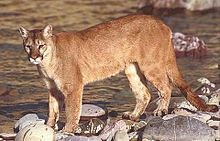
Image Credit: SOURCE/Wikipedia
April 03, 2013 - 4:55 PM
By Julie Whittet
The necessary killing of a wild animal venturing too far from home can be upsetting news for some. Incidents like last Wednesday's shooting of two cougars in Lake Country touch on the delicate balance between wildlife conservation and public safety.
Mike Badry, Wildlife Conflicts Prevention coordinator for B.C., says any decision to pull the trigger on a wild animal reflects a careful and necessary judgement on the part of conservation officers in the field. Ultimately, the decision is “based on risk to the public,” he says.
“It's a sensitive issue, because the public is very attuned to how we manage large carnivores, animals that we see as iconic.”
Conservation officers go through extensive training to deal with human-animal conflicts. Their objective is to assess the behaviour of the animal in question. Officers must gauge how comfortable an animal is with human interaction: “has it lost its wariness? its fear of people? is it comfortable feeding on garbage or pet food?”
Badry says, “animals are individuals, some will go down that path sooner than others.” But when an animal has lost its fear of people, and poses a threat to public safety, non-lethal management is no longer an option.
Not all wild animals caught in human territory will meet such a fate.
Badry says conservation officers will relocate an animal “before it has a chance to go down those paths.”
“If a cougar has not been acting aggressively it could be a candidate for non-lethal management.” Conservation officers must always consider public safety first. Trying to capture and anesthetize an animal can be dangerous work.
Brian Harris, wildlife biologist for the Ministry of Forests, Lands and Natural Resources, says “cougars are really hard to trap, it's not like bears.” Harris says there seems to be more cougar sightings than normal this year, “we usually see half this many."
Harris says, “there are typically 50-70 cougars that are killed every year by hunters, then on top of that another eight to ten taken by conservation officers or accidents.”
For other wild animals that happen to wander into a human community but are still wary of people, they can be caught and moved to a more familiar area. Though officers are not likely to transport an animal great distances.
“To move an animal a long distance is never effective,” Badry says.
He cautions the public spring time is “a high conflict time,” as bears emerge from their winter dens and cougar young start to leave their mothers.
“People need to be extra vigilant not to give them easy access to a food source. Garbage is the number one attractant,” he says. When people are aware and responsible, “there's a lot more opportunity to deal with that animal in non lethal ways.”
To report a conflict with wildlife or dangerous animal, contact the 24-hour Report All Poachers and Polluters hotline (R.A.P.P.) at 1-877-952-7277 or enter your report online at: www.env.gov.bc.ca/cos/rapp/form.htm
To contact the reporter for this story, email Julie Whittet at jwhittet@infotelnews.ca or call (250)718-0428.
News from © iNFOnews, 2013